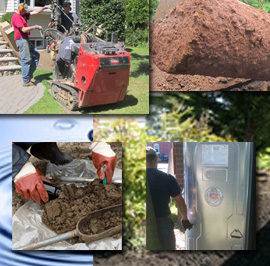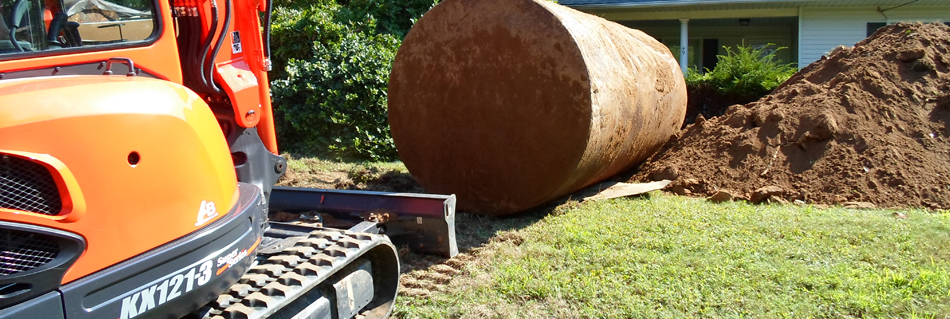ASAP Anderson Residential:
Free quote, site testing, help with permits,
remove AND dispose of your tank AND remediate the site
Now that’s service!
Residential Oil tank removal services, soil testing, site remediation and more services you may need.
The Removal Procedure: Once you give us authorization to proceed with removing your tank, we request “underground utility locations” (you should plan on at least four days).
When we begin work at your location, the underground tank is first exposed and all liquid contents are removed–any piping connected to the tank is also removed. We then cut a hole in the tank so an Anderson technician can enter and thoroughly clean the interior. All of the tank contents are transported and disposed of at a licensed facility*.
It’s time to remove the tank
Once the tank is removed from the ground your local authorities and your Anderson tech. inspects the tank for integrity. Once approved by your local authorities, the tank is transported to a licensed recycling facility for disposal.
The excavated area is backfilled with certified clean fill. Upon completion, Anderson will provide you with all legal documents and certifications that you should safely file away for future reference.
*If a new tank is being installed, the oil can be transferred from the old tank to the new tank.
Oil Tank Testing: Performed using an acoustic ultrasonic EZY 3 Locator Plus. This test is capable of detecting any leakage below or above the liquid level as well as all associated piping. Tank testing is sometimes done for insurance purposes or prior to selling your home. You are provided a preliminary report the same day and a written report within five business days.
Soil Testing: Once you authorize us to proceed with the needed sampling, we request “underground utility locations”– plan on 4-6 days.
Once we know where the utilities are, our technician arrives at your location, he will first determine the location of your piping between your building and the tank. This protects the piping during the sampling process.
He bores for his samples around the perimeter of the tank to about 2 feet below the bottom of the tank. Depending on what’s needed, the tech will either use a hand-held prob or a mechanical geo-probe.
Your samples are sent to a certified lab for analysis and in approximately a week you’ll receive a written report with the results.
Tank Abandonment: The underground tank is exposed and emptied of all liquid product. Any piping connected to the tank is removed. After cutting a hole in the tank, an Anderson technician enters the tank and thoroughly cleans the interior and visually inspects the tank for structural integrity. All of the tank contents are transported and disposed of at a licensed facility. If there is no evidence of tank failure and the municipal inspector approves, the tank is filled in place with either pea gravel or slurry mix (k-crete). The excavation is then backfilled with clean fill. Upon completion, Anderson will provide you with all legal documents and certifications that you should safely file away for future reference.
The Soil Remediation Procedure: Prior to beginning soil remediation, a delineation may be performed to determine the extent of contamination. This is done using a geo-probe for soil samples. Anderson will carefully analyze the findings, determine the most economical way of proceeding, and provide you with a comprehensive proposal for the soil remediation. Excavation will then take place to remove the contaminated soil and have it transported and disposed of at a licensed facility. After the excavation is complete, soil samples will be taken to a NJDEP certified lab to be analyzed. The excavation is then filled with certified clean fill and compacted in layers to minimize any settling.
The Water Remediation Procedure: If ground water has been impacted, it is common for the homeowner’s insurance company to become involved, as this generally triggers a third party liability claim. Anderson will work with your insurance carrier during this phase.
Reporting to the NJDEP: When all remediation has been completed, an Anderson associate will generate a comprehensive RI/RA Report for submittal to the NJDEP. This report will contain a Preliminary Assessment, Remedial Investigation, detailed Remedial Action Work Plan, and Remedial Action Report. Once approved, the NJDEP issues a “No Further Action” (NFA) letter.
COMPLETE SITE RESTORATION: When Anderson completes a tank removal, the excavated area is backfilled to rough grade. We also offer our services to perform any additional restoration which may be requested, i.e.—topsoil, sod, concrete walkway, asphalt, etc.
Above Ground Oil Tank Installation: Anderson is an authorized installer of ROTH® Double Walled Oil Tanks. Roth Eco DWT PLUS 3 tanks feature a 30-year warranty and provide ultimate safety and reliability. Roth tanks are manufactured in the USA.
Anderson also installs other brands of quality tanks which are available in various capacities.
Concern #1 before calling Anderson:
“I think my tank is leaking…at least it could be…I don’t know, how do I find out…?”
Well, there’s only one way to find out: Call an Oil Tank Professional: Anderson Environmental—Relieving concerns and removing oil tanks since 1994.






